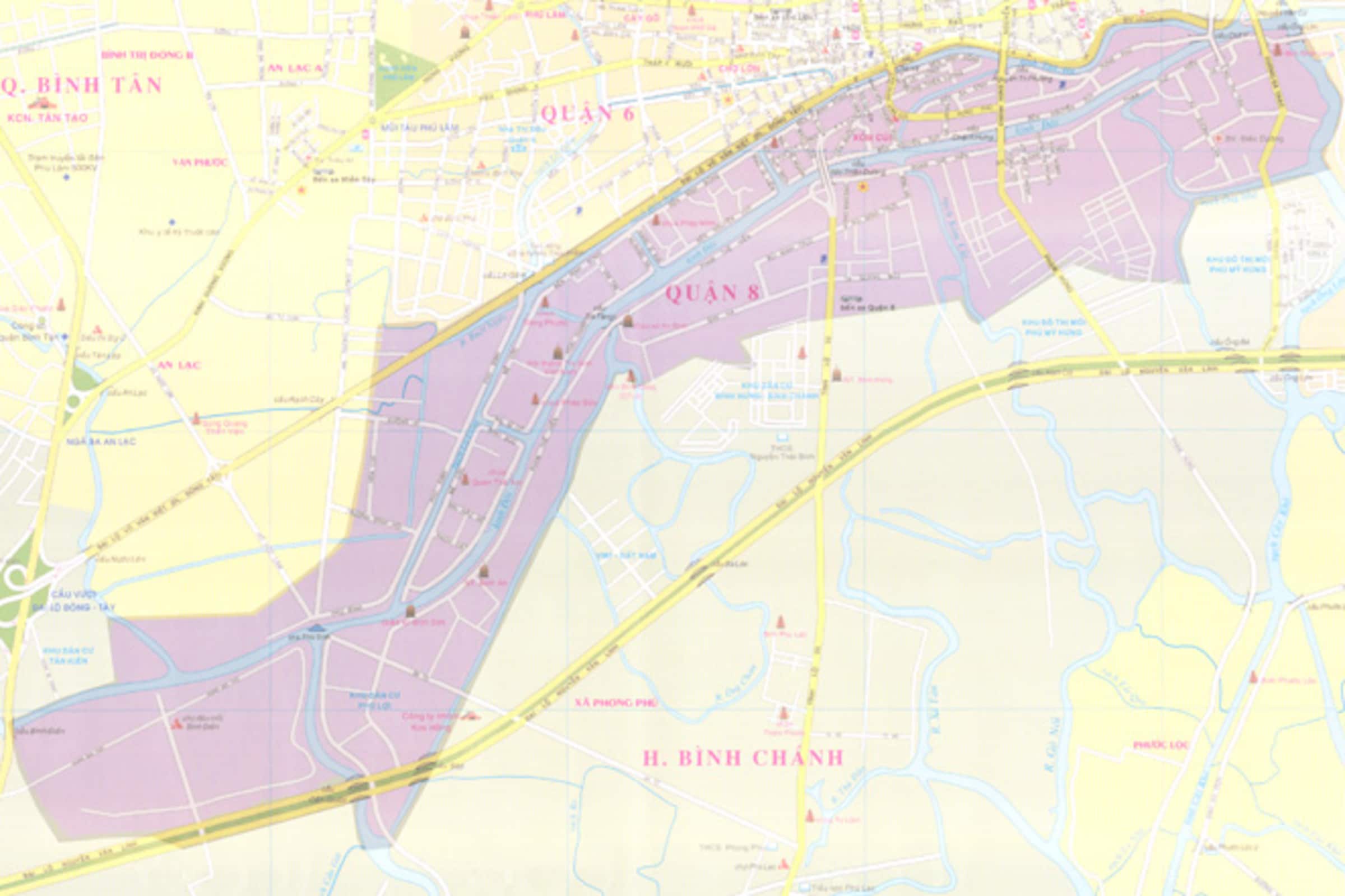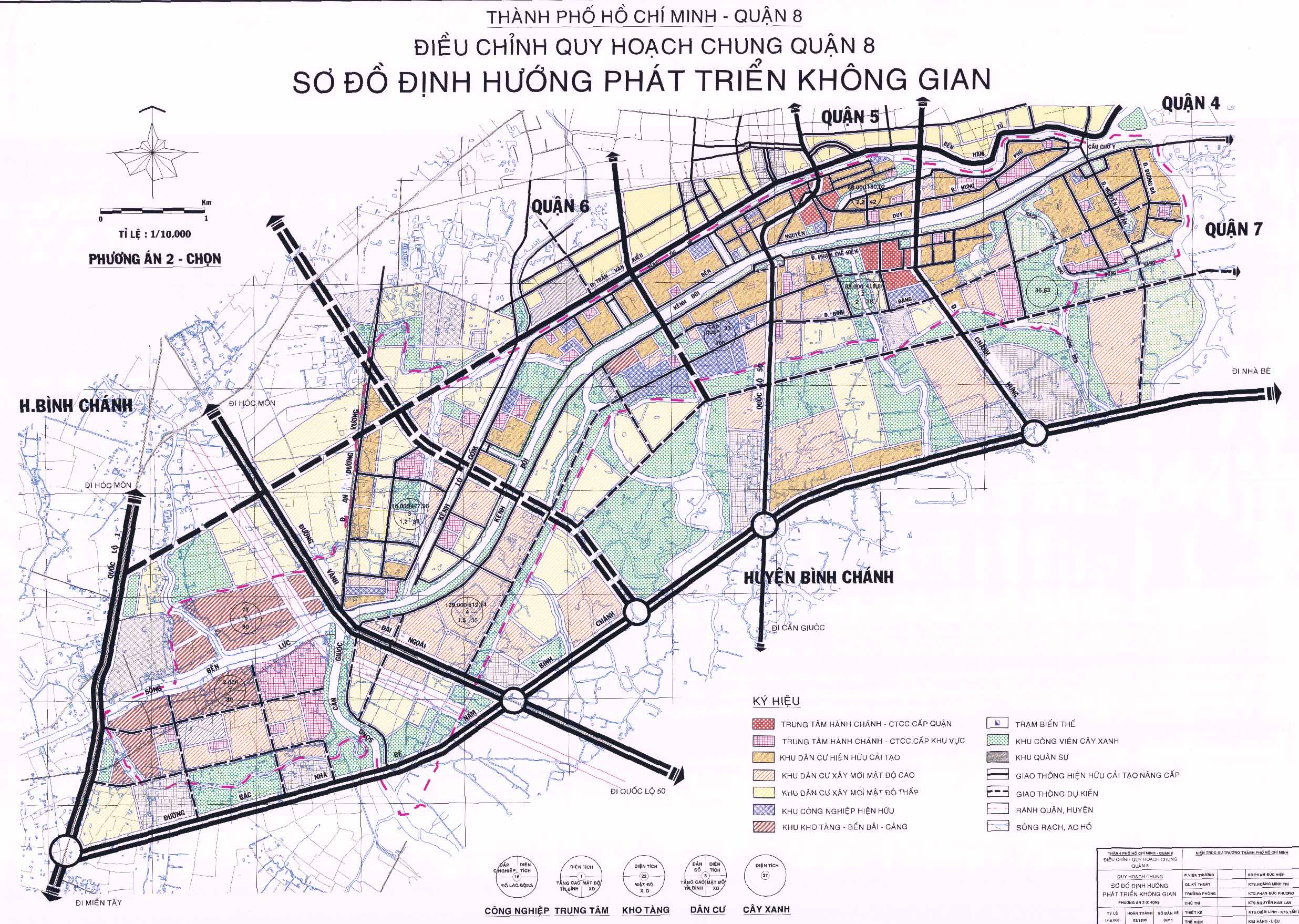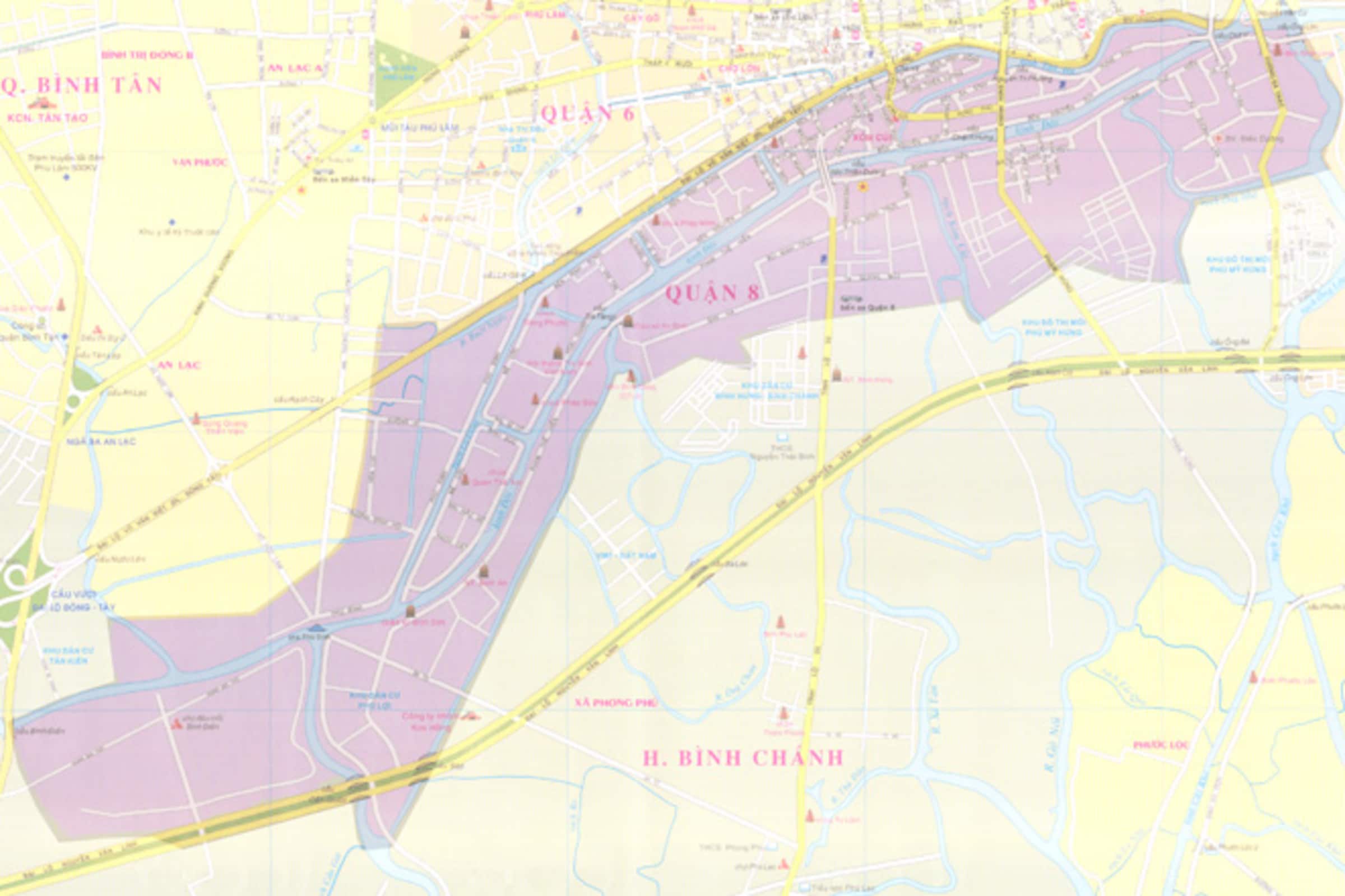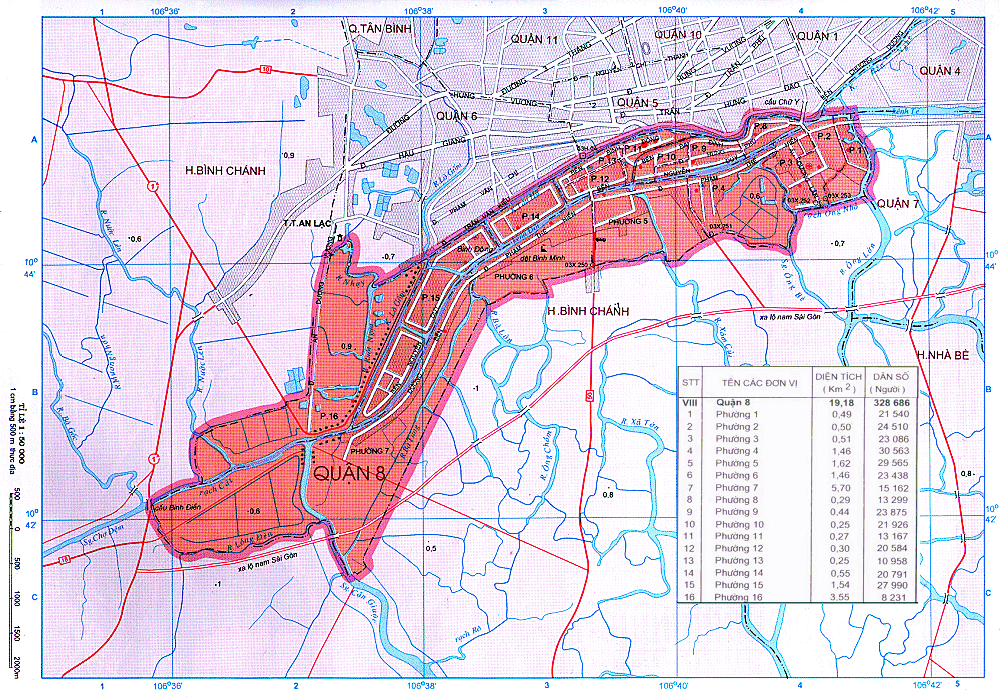You are looking for a large administrative map of District 8 or an administrative map of wards in District 6 in Ho Chi Minh City, for convenience in looking up planning information.
We truongptdtntthptdienbiendong.edu.vn synthesize and share the detailed enlarged map of District 8 in 2023. In addition, we also provide and share economic information, traffic and “the process of formation and development of District 8” .

About District 8
District 8 is located on the southwest of Ho Chi Minh City (HCMC) in the region South East and its head office is located at 4 Duong Quang Dong, Ward 5.
As of 2023, the natural land area of District 8 is 19.11 km² (population in 2019 is about 424,667 people), the administrative unit is divided into 16 wards: 1, 2, 3, 4, 5, 6, 7, 8, 9, 10, 11, 12, 13, 14, 15, 16 .
The long diamond shape of District 8 is strongly divided by a system of interlaced canals, in the northeast-southwest direction extending along Tau Hu and Doi canals.
About geography
- To the east, it borders District 7 through Ong Lon canal
- To the northeast, it borders District 4 through Te . canal
- The West borders Binh Tan district
- To the south, it borders Binh Chanh district
- The North borders District 5 and District 6 with the boundary of Tau Hu canal and Rot Ngua canal.
Administrative map of District 8 Ho Chi Minh City in 2023




ENLARGE
Learn about the formation and development of District 8
On the map of Ho Chi Minh City, District 8 looks like an elongated line running in the East – West direction, located in the West – South of the City.
As a suburban district of the inner city, District 8 borders District 5 in the North, taking Tau Hu canal and Ngua intestine canal as the natural boundary, the East adjoining District 4 and District 7, taking Ong Lon canal as the natural boundary, and The West and South borders Binh Chanh district, the boundary is not clear, because it is a field.
If you rotate the map of District 8 to the south, you will see that it looks like a phoenix-tail boat, the bow is on the Ong Lon canal, the boat’s stern is on the Can Giuoc river, the length is 5.2 times the width. If you use a boat to go on a section of Kenh Te, continue to Kenh Doi, cross Cho Dem river to the end of District 8, you have to go a waterway 11,850 meters long. But if you cross the direction of District 8, only about 2,252 meters is the widest area bordering District 5 and District 6.
With a circumference of nearly 32 km, District 8 is 4 times larger than District 3, District 4, District 5, equivalent to Go Vap District, but the natural area of 1,880 hectares of District 8 is divided by many rivers and canals unlike the district. which is in the inner city.
The Double Canal is like a backbone that runs through the District and divides the District into two long and narrow pieces. Ben Nghe canal, Tau Hu canal, Ong Lon canal, Ong Nho canal, Xom Cui, Ong Nha, Rut Ngua, Rach Cat, Ba Tang, Long Den, Rach Cung, Lo Gom canals, then Ngang canal No. , Channel Ngang No. 3 subdivided District 8 into pieces.
That fragmented terrain, along with its position as a buffer zone between the inner city and the suburbs, the semi-agricultural – semi-market area, during the war, District 8 was an ideal location for the development of guerrilla warfare as well as the construction The guerrilla depressions, the powerful springboards of the revolutionary war were right in the heart of the enemy’s biggest stronghold, Saigon – Cho Lon, Gia Dinh.
From an economic point of view, the topography of District 8 with the semi-diurnal tidal regime makes the rivers in District 8 contaminated with alum and salt, especially in the area of wards 11, 12, 13 and 16. But District 8 is not without Many areas are accreted by alluvial rivers, creating an agricultural area of District 8 that is nearly ½ of the total area. In District 8 there are green rice fields (bordering Binh Chanh district), large sedge fields, vegetable fields, coconut and fruit orchards around fish ponds, which have a rural rather than urban feel.
The tropical monsoon climate, hot and humid temperatures are generally favorable for settlement and agricultural development.
About traffic in District 8
The most convenient transportation in District 8 is waterways because of the system of 23 large and small canals in the district connecting the wards with each other and with other localities inside and outside the city.
The Double Canal is 50 meters wide and 20 meters deep, which can accommodate large ships. Other canals and rivers are both deep, wide and long, creating traffic arteries that no other district has.
However, the road traffic system in District 8 is also quite developed. Pham The Hien Street connects District 8 with the city center, other roads and alleys are interwoven to form a cobweb traffic system throughout the District.
Especially the bridge system of District 8, with 44 bridges, the total length is more than 2,500 meters. Bridges such as Y-shaped bridge, Nhi Thien Duong bridge, Cha Va bridge, Hiep An bridge with large tonnage were built a long time ago and upgraded many times, increasing its traffic gravity.
The meeting place for water and land traffic are wharves and ports, another strength in traffic and economy of District 8. The whole District has 14 wharfs, the ports of Chanh Hung, Duong Ba Trac, Binh Dong and Binh Loi. .
Port in District 8
Adjacent to the port is a system of treasures dating from the beginning of the twentieth century to the present. The whole District 8 has 83 large and small warehouse facilities with an area of 278,640 m2, including 30 warehouse facilities managed by the Central Government, 33 warehouse facilities managed by the City and 20 warehouse facilities under the District.
All make up a District 8 which is a “large-scale transshipment station” in the West – South of the City, making District 8 one of the important port districts of Ho Chi Minh City.
Although it is an inner-city district, District 8 sells agricultural products and markets, the economy includes agriculture, industry, handicrafts, services and commerce, etc. The unique economic structure is suitable for the location of the buffer zone. of District 8 and first of all it is the product of the combination of the population groups that converge here.
Farmers from Can Giuoc, Can Duoc, Duc Hoa came to this land to explore and cultivate agriculture. Poor workers from the North, Central, and Southeast come to the ports here to sell their labor to port owners, owners of rice millers, flour mills, and merchants. Those are the two largest sources of residents since the end of the last century, gathered in District 8.
After that, poor farmers and laborers from the West, East, and other localities The city gathered in the buffer zone of District 8, bringing the population of District 8 during the war years to tens of thousands of people, with 2 main components are workers and farmers.
History of District 8
In 1698, when Nguyen Huu Canh went to the South to establish Gia Dinh government with 2 districts of Phuoc Long and Tan Binh, the area of District 8 now belongs to Tan Long, Tan Binh district.
In the Gia Long Dynasty, the year of the Dragon year (1808), Tan Binh district became Tan Binh district, the two cantons of Binh Duong and Tan Long became districts, adding 2 cantons to each district, taking the two letters of the district and putting the name of each canton at the beginning of the name of each canton. . Binh Duong district has two cantons: Binh Tu and Duong Hoa. Tan Long district has two cantons, Tan Phong and Long Hung. The land in District 8 today is located in Tan Phong canton, the southern strip of land belongs to Long Hung canton.
According to the list of villages, wards, hamlets and prostitutes made by Trinh Hoai Dat in the list. “Gia Dinh Thanh Thong Chi”, compared with some places that still exist today, under Gia Long dynasty, on the land of District 8 today, there were Long Vinh, Binh Long, Hiep An, Tan Nhuan villages. , Binh Dang, Binh Dong, Tu Xuan, An Phu Tay, ..vv…
Under the reign of Minh Mang, the population increased much, the land was also exploited more. In 1836, the delegations of Truong Quoc Que and Truong Minh Giang carried out a large-scale survey to establish the terrain for each village and ward. On this occasion, the administrative units were adjusted to suit the locality. Therefore, a number of communes and wards were added.
According to local research documents on Gia Dinh province under Minh Mang’s reign, District 8 at that time consisted of many villages and wards belonging to many sums of two districts of Binh Duong and Tan Long. It is the hamlet of Binh Thuyen of Ong Lon canal country of Binh Tri Thuong canton, Binh Duong district, Hung Thanh village, Tan Quang village of Tan Phong Thuong canton, Binh Long village, Hiep An village, Luong Hoa Dong village, Phong Phu village. , a part of Tan Nhi Dong village, Thai Phong village, a part of Phong Duoc village, belonging to Tan Phong Ha canton, Hoa Muc village, Hung Phu village, Long Vinh village, Tan Thuan village, Thuan Duc village, Vinh Hoi village, a part Chanh Hung village, belonging to Tan Phong Trung canton, a part of An Phu Tay village belonging to Long Hung Ha canton, Tan Long district.
The above hamlets existed until 1859 under the reign of Tu Duc, the French colonialists captured Gia Dinh citadel and established colonial rule throughout Cochinchina in the six provinces. In the area of Ben Nghe and Saigon are two important economic centers, the French established two separate streets, with the name Saigon City is the old Ben Nghe area, Cho Lon City is the old Saigon area.
Cho Lon city at first was mainly a trading and handicraft production area of the Chinese, with an area of only about one square kilometer. After the situation stabilized, more and more people migrated or migrated to do business, and the scope of Cholon City was expanded. Rural villages adjacent to the city were merged in turn, including villages located along the banks of An Thong river and Kinh Ruot Ngua in District 8. In 1905, the French dug Kinh Te from Rach Ban estuary. adjacent to the Saigon River where Tan Thuan Bridge reaches the An Thong River, crosses the Ong Lon canal with a length of 4,200 meters, making an important waterway going down to the West, boats no longer have to enter the Ben Nghe river at Khanh Hoi bridge. The last section of this canal flows through District 8 in wards 1 and 2 today.
Following in 1906 – 1908, the French again dug Kinh Doi, from the Y-shaped bridge, at the confluence of the An Thong (Tau Hu) and Kinh Te rivers, to the Can Giuoc river, 8,995 meters long and 85 meters wide. Digging land is brought to the two banks, creating a ground for people to gather to build houses. The population increased rapidly.
In 1931, the French merged the two cities of Saigon and Cho Lon together into a single administrative unit, called the Saigon – Cho Lon area. The new city area is divided into 5 districts, the police consider security and order, and in terms of administration, the city manager works directly with households as the administrative infrastructure unit. At that time, there were a number of households in District 8 such as household 12 in ward 15, Xom Cui, household 16 in Phu Dinh, household 17 in Ba Tang bridge area…
The above administrative system lasted until the August Revolution and during 9 years of resistance against the French colonialists. In 1963, Bao Dai’s government also rearranged the administrative units of the Saigon citadel, re-dividing the area of District 8 today at that time as District 4 and District 5.
After the Geneva agreement, the Saigon government carried out a broad reform in the administrative base. The capital city of Saigon is divided into 8 administrative districts. The area of District 8 today is the new District 7 and District 8, each district is divided into many wards. Each ward is divided into several clans.
District 8 has 5 wards: Xom Cui, Hung Phu, Binh An, Chanh Hung and Rach Ong. District 7 has 6 wards namely Cay Sung, Binh Dong, Rach Cat, Phu Dinh, Ben Da and Hang Thai wards. This administrative change was maintained until the liberation date of April 30, 1975.
After the South was completely liberated, the Revolutionary government reorganized the administrative facilities in the city. Districts and districts also changed, in which the old District 7 and District 8 were merged into District 8 with 22 new wards, named by number, from number 1 to number 22.
On July 17, 1986, implementing Decision No. 8-HDBT, the wards of District 8 were adjusted as follows:
- Merged part of old ward 3 with part of old ward 2 into new ward 3.
- Merged the rest of the old ward 7 with the old ward 8 into the new ward 5.
- Rename the old wards 9 to the new ward 6, the old ward 22 to the new ward 7, the old ward 10 to the new ward 8.
- Merging part of the old ward 12 with the old ward 11 to form a new ward 9.
- Merged the rest of the old ward 12 with the old ward 13 to form the new ward 10.
- Merged part of the old ward 15, part of the old ward 16 and ward 14 into the new ward 11.
- Rename the rest of ward 16 to the new ward 13.
- Merged part of the old ward 19 with ward 18 to form a new ward 14.
- Merged the rest of the old ward 19 with the old ward 20 to form the new ward 15.
- Rename the old ward 21 to the new ward 16.
After adjustment, in 1986, District 8 was left with 16 wards, named from number 1 to number 16 and that adjustment has lasted to this day.
Thus, the place name of District 8 has only appeared nearly half a century ago, but the area of District 8 today was more than 300 years ago along with the history of Gia Dinh land at that time.
What year is 2023? What order? Age of the Rabbit is suitable for which age?

